 For our plant comparison we are going to look at dandelion (which most people know) and cat’s ear (a similar looking plant). Beginning with this image of a lush dandelion (Taraxacum officinale), we can see lots of flower heads and a number of new heads forming, along with some closed heads which bloomed recently. The dandelion could almost be an evergreen plant as it seems to grow year-round — at least whenever the temperature stays above freezing. Let’s go through the dandelion’s life cycle and then check out the cat’s ear similarities and differences.
For our plant comparison we are going to look at dandelion (which most people know) and cat’s ear (a similar looking plant). Beginning with this image of a lush dandelion (Taraxacum officinale), we can see lots of flower heads and a number of new heads forming, along with some closed heads which bloomed recently. The dandelion could almost be an evergreen plant as it seems to grow year-round — at least whenever the temperature stays above freezing. Let’s go through the dandelion’s life cycle and then check out the cat’s ear similarities and differences.
The dandelion’s flower head begins developing low in the center of the rosette of leaves.
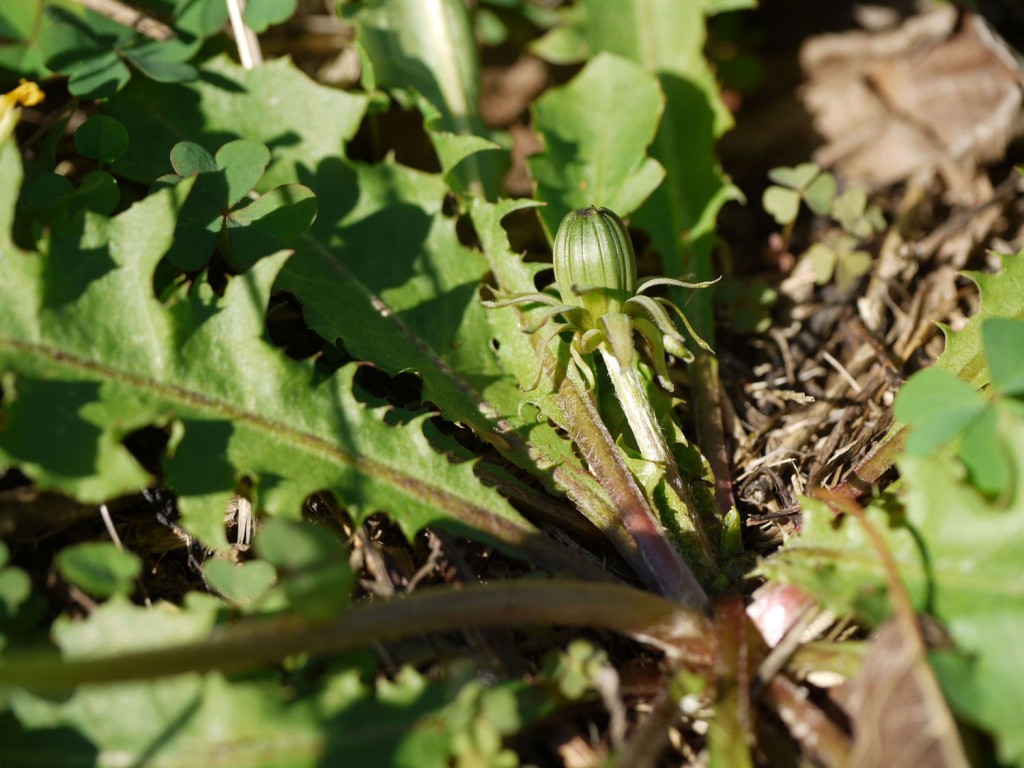 Gradually, the stem supporting the new flower head elongates until it rises well above the basal rosette.
Gradually, the stem supporting the new flower head elongates until it rises well above the basal rosette.
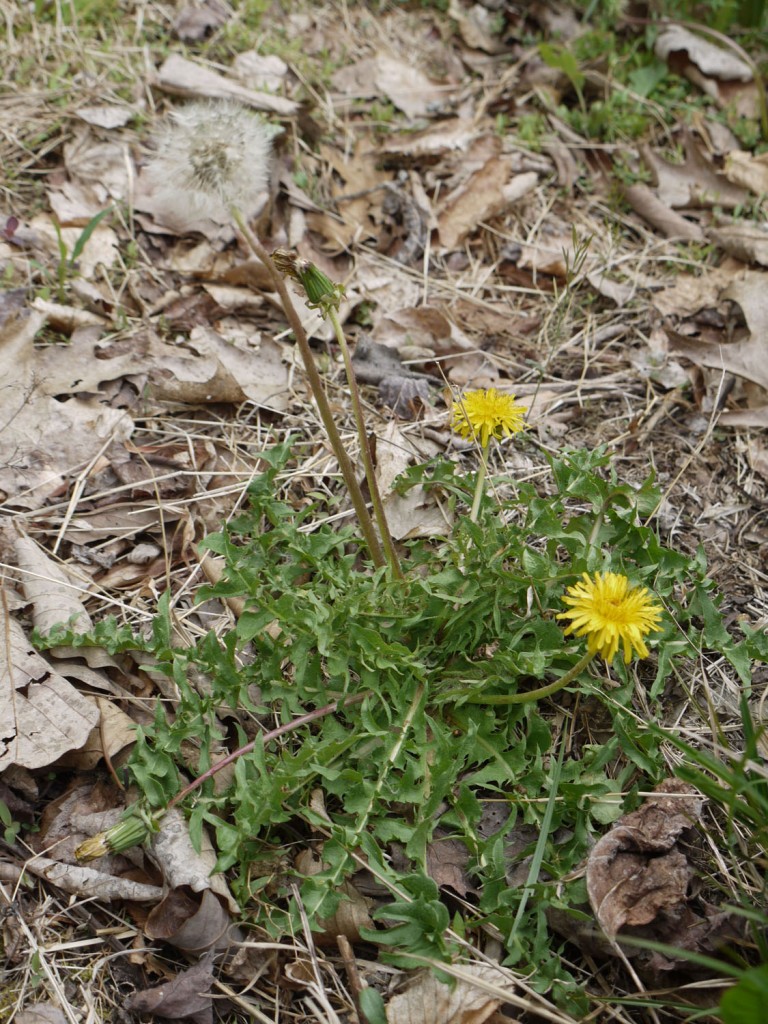 The dandelion’s hollow stem exudes a milky white substance (a type of latex) when broken. After the flower head has blossomed, it closes in on itself . . .
The dandelion’s hollow stem exudes a milky white substance (a type of latex) when broken. After the flower head has blossomed, it closes in on itself . . .
 . . . converts those fertilized ovaries to seeds with wings . . .
. . . converts those fertilized ovaries to seeds with wings . . .
 . . . and re-opens to create the familiar seed head which, once again, rises high above the basal rosette of leaves.
. . . and re-opens to create the familiar seed head which, once again, rises high above the basal rosette of leaves.
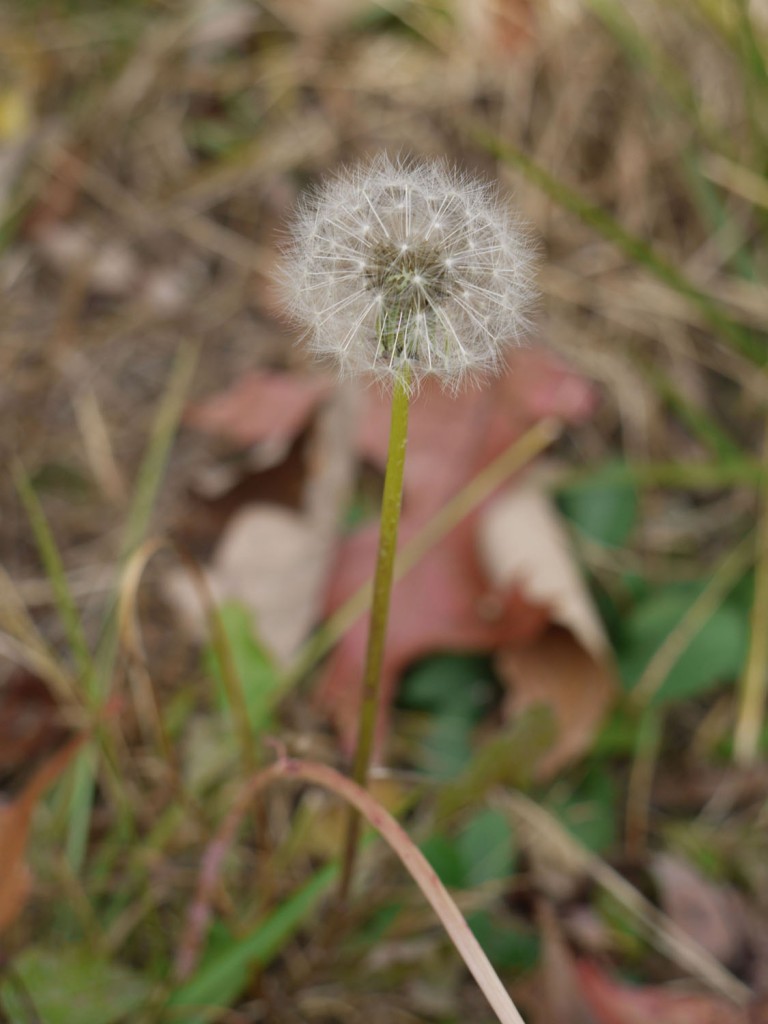 Note the fleshy stem supporting the seed head. Here’s a closer view of that head with its symmetrical arrangement of the winged seeds.
Note the fleshy stem supporting the seed head. Here’s a closer view of that head with its symmetrical arrangement of the winged seeds.
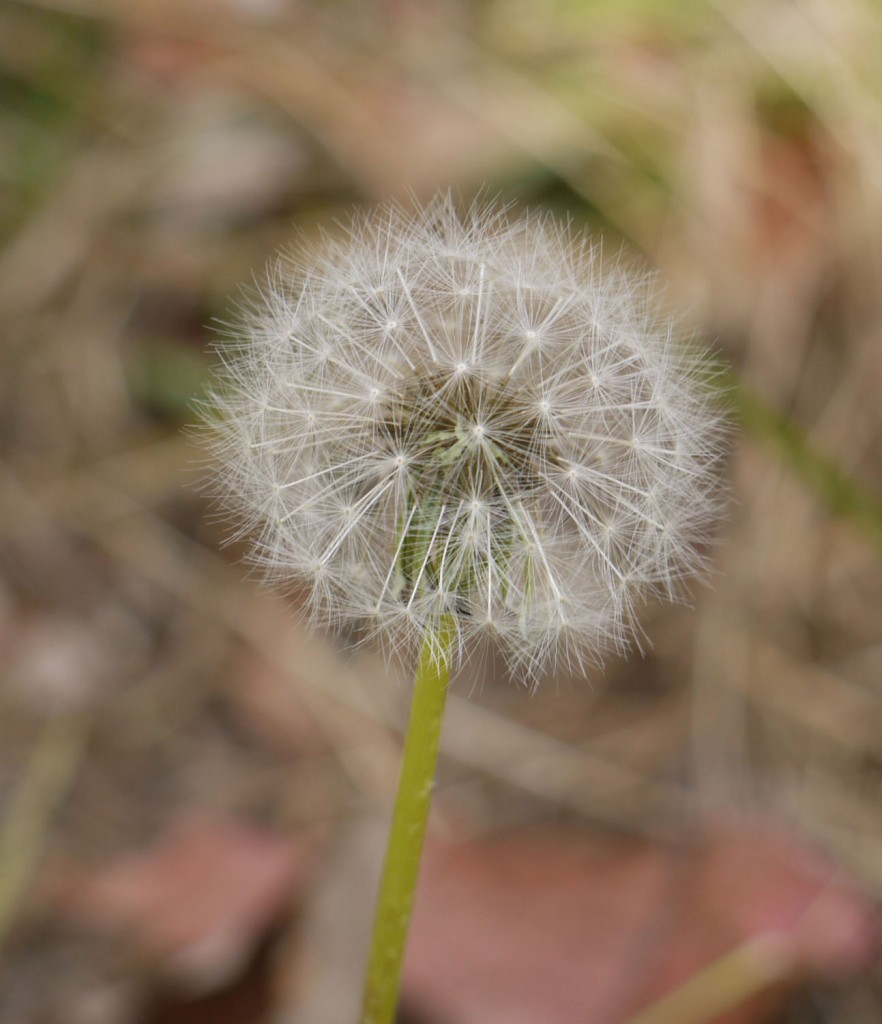 After all the seeds have dispersed, what remains is the head’s receptacle. It, too, has a lovely pattern.
After all the seeds have dispersed, what remains is the head’s receptacle. It, too, has a lovely pattern.
 Here is a final view of a dandelion plant. You can see that most of its flowers have converted to seeds and/or have sent the new seeds on their way — to the irritation of people who want perfect lawns — and to the delight of herbalists and wild food foragers.
Here is a final view of a dandelion plant. You can see that most of its flowers have converted to seeds and/or have sent the new seeds on their way — to the irritation of people who want perfect lawns — and to the delight of herbalists and wild food foragers.
 Cat’s ear (Hypochoeris radicata) looks, on first glance, very much like the dandelion — especially when you see an area full of the plants.
Cat’s ear (Hypochoeris radicata) looks, on first glance, very much like the dandelion — especially when you see an area full of the plants.
 Let’s look more closely at this plant. Here is its flower head . . .
Let’s look more closely at this plant. Here is its flower head . . .
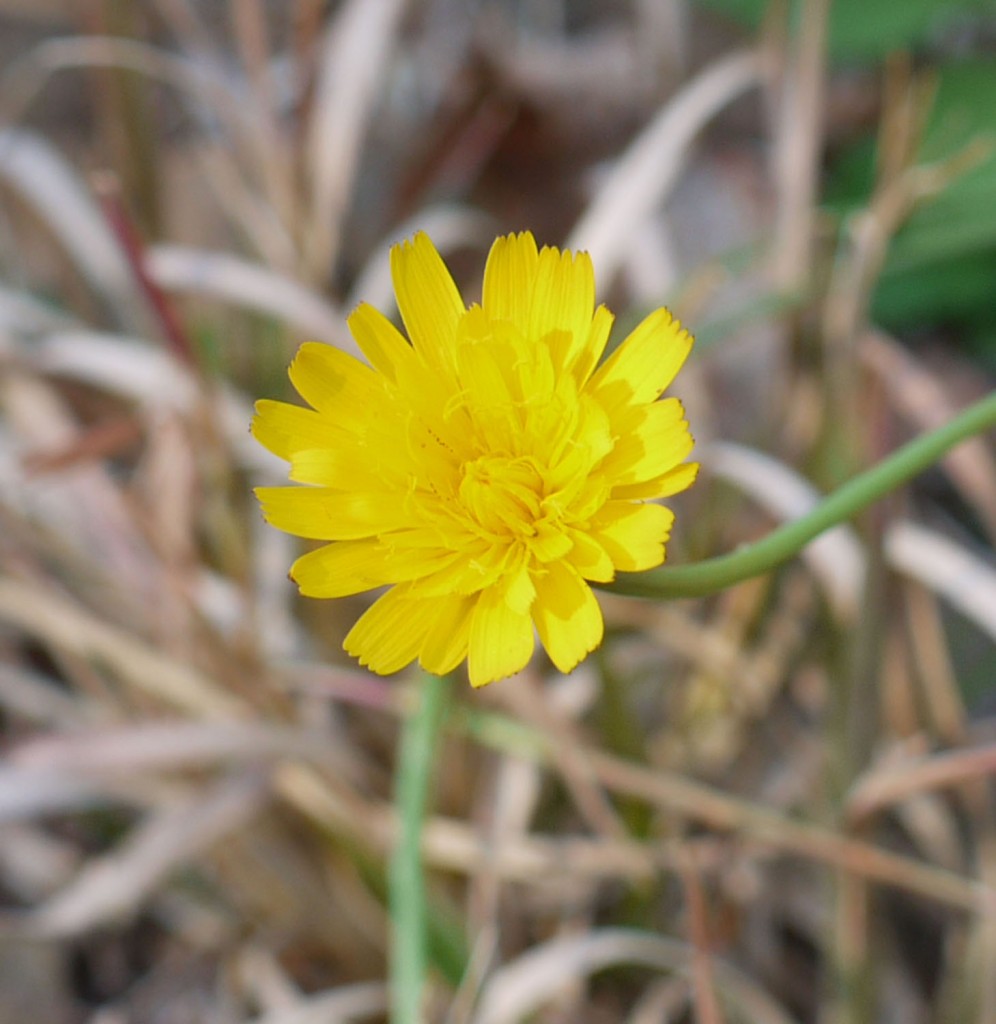 . . . which, in isolation, looks like a dandelion flower head. However, note its more wiry stem in the photo above and the next photo.
. . . which, in isolation, looks like a dandelion flower head. However, note its more wiry stem in the photo above and the next photo.
 You can see a developing flower head in the background of the above photo. This flower head looks similar to — and yet, different from — the dandelion flower head. The difference is subtle.
You can see a developing flower head in the background of the above photo. This flower head looks similar to — and yet, different from — the dandelion flower head. The difference is subtle.
As we stand back and look at the entire cat’s ear plant, we can see its flower heads rise on stems above the basal rosette of leaves.
 Although frequently a single flower head grows on a single stem (like the dandelion), it is just as likely the cat’s ear flower heads will appear on a branched stem. In contrast, the dandelion’s single flower head will only appear by itself on an unbranched stem. Along with the branched stems, this next photo shows the wiriness of the stems and the different looking unopened flower heads.
Although frequently a single flower head grows on a single stem (like the dandelion), it is just as likely the cat’s ear flower heads will appear on a branched stem. In contrast, the dandelion’s single flower head will only appear by itself on an unbranched stem. Along with the branched stems, this next photo shows the wiriness of the stems and the different looking unopened flower heads.
 After the flower heads have bloomed and become seeds, the heads re-open and spread their winged seeds — just like the dandelion.
After the flower heads have bloomed and become seeds, the heads re-open and spread their winged seeds — just like the dandelion.
 Here’s a view of the basal rosette of a cat’s ear plant.
Here’s a view of the basal rosette of a cat’s ear plant.
 And this is where we can finally see some distinguishing characteristics between dandelion and cat’s ear. The cat’s ear leaves are quite hairy while the dandelion leaves are smooth. When you look closely at the shape of the leaves — by placing them side by side — you can see the dandelion is definitely sharply toothed, with its teeth pointing back toward the center of the plant.
And this is where we can finally see some distinguishing characteristics between dandelion and cat’s ear. The cat’s ear leaves are quite hairy while the dandelion leaves are smooth. When you look closely at the shape of the leaves — by placing them side by side — you can see the dandelion is definitely sharply toothed, with its teeth pointing back toward the center of the plant.
 Those softly hairy leaves probably account for the common name given to cat’s ear.
Those softly hairy leaves probably account for the common name given to cat’s ear.

Thank you so much for this comparison. I read more on Wikipedia about cooking them, but liked all your photos! I will have to try eating them once. lol
This brings memories of my grandmother in Ashland Ohio going picking dandelions greens to cook and me playing with the flowers as a kid she got me wanting to identify different plants
I have another plant that looks similar to catsear, it has a yellow flower and the root crown leaves look similar to dandelion or catsear, but has long skinny leaves on the flower stem that look almost like small curly dock leaves. What is it?
Tom, unfortunately there are a number of plants which are similar to the common dandelion. Another one I have here is called Meadow hawkweed (Hieracium caespitosum) which has narrower basal leaves. This year I realized there’s even another yellow-flowered plant in my yard whose basal leaves remind me of dandelion so much that when I first saw it in the early spring I thought it was actually a dandelion. I have yet to study the field guides in order to identify it. I could not begin to name your plant without a number of really good photos of it so I suggest checking a field guide for plants local to you.
Might be hawkweed.
Hieracium – Wikipedia, the free encyclopedia
en.wikipedia.org/wiki/Hieracium
Pingback: Yellow field flowers | Identify that Plant
Can we eat the cats ears? Thanks for the photos they are very clear.
Rebeka, I have read that Cat’s ear is edible. I recommend looking for more info on that from some reputable foragers.
I am getting confused!
I think from many other sites that this is definitely a Hawkweed (Hieracium)
Am I right or wrong?
Someone please write me to confirm! Thank you!
Stella, neither one of the above plants is Hawkweed (Hieracium spp.). The two plants featured above are Dandelion (Taraxacum officinale) and Cat’s ear (Hypochoeris radicata).
For a comparison between Cat’s ear and Meadow hawkweed (Hieracium caespitosum), read the following blog post: http://www.identifythatplant.com/yellow-field-flowers/ You can easily find this second blog post by searching for “hawkweed” in the search box at the top of this page.
I am so happy to find the definition and the differences between these two plants! I have been telling my friends that they are not the same plant! I am a photographer and needed to get this ID’d before I printed the wrong name of the plant I shot!
YAY!
I know it seems silly, but a great sigh of relief!
Mari
Mari, I totally understand. I, too, feel tremendous relief when I finally identify a plant which has been puzzling me for a long time.
Incredible points. Outstanding arguments.
Keep up the great spirit.
These are very interesting comparisons! I was wondering if there was a plant which resembles the common dandelion that is poisonous?
Although I am not aware of any plant, looking like dandelion, which might be poisonous, I guess it is always possible. However, Steve Brill insists there are no poisonous look-alikes: http://www.wildmanstevebrill.com/Plants.Folder/Dandelion.html
I’m so glad to learn about these herbs I habe dandelion plants in my garden besa they are same as in the picture of dandelion I would like to pick them and use in my soup
Thank you so much for the clear explanation and fabulous pictures. My yard is full of cat’s ear plants and I thought they were a type of dandelion and couldn’t find out anything to give me a hint they were another type of plant altogether. I was so relieved to find your page!!! I was wondering if they were edible as they are so similar to dandelions. Now I can look them up and find out about them. Again, thank you.
Gail, I have read that Cat’s ear is edible. I have not personally tried to eat this plant though. I suggest looking for a reputable forager who might have more info about this.
I was wondering if the plants on my local heath were cats ears or not, so googled it. Thank you for such a definitive and well presented answer.
And, yes they are.
Thank you so much for this informative article. I too thought I had dandelions in my garden, but now know they are cats ears.
I’m looking forward to following your links to check out the properties and benefits of cats ears.
Do you have any links of a reputable forager?
Thanks once again
Bev
Johannesburg, South Africa
Bev, you might check the page for Foraging Resources here. http://identifythatplant.com/foraging-resources/
Following some of those links may point you to someone in your region.
Hello Angelyn,
Great website you have! Cat’s ears’ leaves and roots are edible!
Would you be willing to list my website and FB page on your resources page? I am a Master Naturalist, Wild Food Educator as well as a writer/researcher living near Toronto. My website.. http://www.ediblewildfood.com/ and my Facebook page has over 23,000 likes – the name of the page is EdibleWildFood.com.
Thanks!
Karen
I like your postings.
Edible is not the same as palatable. Most of these composites are edible but bitter – even taraxacum / true dandelion is too bitter at the wrong season. Sort of like lettuce if allowed to grow too long or in the wrong conditions – similar plants and flavors. Arthur Lee Jacobson (wise eccentric plant person) commends Hairy Cat Ear as better than dandelion. http://www.arthurleej.com/a-catsear.html Another one of the milder composites is nipplewort – a bit fuzzy but quite tasty.
My favorite way to eat dandelion is early spring when the flower buds are tight in the crown. I pop the fat flower buds out of the crown and into my mouth. Not sweet like candy, but bursting with flavor and only mildly bitter.
Dandelion thrives in rich soil, HCE does best in poor soil. HCE also has a biochemical way of inhibiting both grass and itself, so that one rarely sees HCE as a wall to wall mass, but rather patchy, and a dead zone under the flat leaves, (that fortunately fills in quickly once the HCE is cut out).
Thanks for your contribution, Glen. I also enjoy the dandelion flowers. I usually pinch off the outer green portion and savor the yellow flowers. Next chance I get, I’ll taste-test the buds while they are tight in the crown as you have suggested.
Yes taraxacum can be bitter, especially water derived by boiling it, however it can be comparable to coffee, which is definitely palatable 🙂
Thank you for this most interesting comparison, with all the great photos and explanation. I learn so much from this site.
Pingback: Plants for temperate climate perennial living mulch cover crop - Peregro
Pingback: Ring Mt. rings with Jim – 11 May 2015 | Zulu Thoughts
Pingback: Dandelion Root Coffee | Pure and Simple Recipes
Pingback: Dandelion Root Coffee | Forest and Fauna
Hello, I was wondering if you have ever know the cat ears plant to get over 4 feet tall. The one I have in my back yard is taller then my fence.
No, Cat’s ear does not grow that tall. Its maximum height would be about two feet. It sounds like you have a different plant.
Sounds like possibly Salsify
Pingback: Peeled garlic, burned rice | Dead Voles
Pingback: Anyone ever replaced their grass with clover? - Mothering Forums
this is the first year i found some dandelion “mutations” as i called them; your wonderful pictures and description certainly were a big help in giving them their real name!
Pingback: 3 Delicious Dandelion Tea Recipes | The Homestead Survival
Pingback: at honeyman state park {on earth day} - WoolyMossRoots
It’s a good work and shows clear difference between dandelion and Cats’ear.
So nice of you.
I have plants that spread thru runners on top the ground like strawberry. They also spread under the ground same way. They are very close to the ground, and choke out everything in their path. Leaves are rounded, small and very hairy. Blossoms look like dandelion and seed the same. They have taken over my lawn, are very resistant to chemicals. I have found the best defense to these plants seems to be rabbit manure or cat urine from when I clean litter box. (Items at hand). Spread over top of plants, seems to kill only that, then grass grows over. Would like correct name of plant, also to know if the lack of uric acid in my soil has something to do with why it grows in my lawn and not other places in our area. The neighbors think I’m nuts, spreading used cat litter over my yard in patches to battle this plant.
We have these wild flowers in England too. Visiting the south coast near Exmouth I noticed what I assume now to be Cat’s Ear though I thought it had a hairy stem.
I used to make wine from the yellow dandelion heads spending hours picking them, then ensuring there was no green part of the flower which would give the wine a bitter taste. The roots I understand can be roasted to give a chicory taste which is a substitute for coffee.
The one thing not mentioned in the excellent article is where the dandelion gets its name. The leaves look like lion’s teeth, which translates in French as dents de lion (teeth of lion), hence dandelion.
Pingback: Connecting Children with Nature – Wildwood Enterprises Inc
Pingback: Foraging – Spring Edibles Pt. 3 – Love Learn Wander
Pingback: Give this Traditional Dandelion Greens Recipe a Try this Spring | Soft Tracks Outdoors
Pingback: Backyard Foraging: Dandelion (Uses & Identification) - Beautifully Bohemian
Thank you for posting this! Just today on my walk I saw these two plants side by side. I was surprised to see how similar they were, and was just about to look them up when I saw your post. Quite a coincidence.
Thanks so much!!!! This is just what I needed!!!
Great site! It has come up twice for me during identification questions and answered them perfectly. Thank you!
I can’t see the difference between the 2 flowers can you be more specific about how they are different. 😉
There actually is not much difference visually between the two flowers. You have to look at the other characteristics of the plant (leaves, stem) to be able to identify it accurately.
just the right level of detail thank you. Came here after I avoided mowing a patch of these then was accused of leaving dandelions to grow…
False dandelion is dangerous for horses. My thoroughbred gelding developed a taste for them and this resulted in Stringhalt. He had to be put to sleep as he had great difficulty walking and became afraid to leave his stall.
Pingback: 3 Medicinal Roots to Gather in Early Spring • One World Herbal Community
Pingback: Foraging Part 4: Dandelions,Cat’s Ear, Milk Thistle, Wild Allium (Garlic) – Ms XX FAST – Life in the Not-So-Fast Lane
Pingback: Delightful things you can make using dandelions from your backyard
Is there any culinary and medicinal value of cat’s ear?
I’m not aware of any medicinal value. I have read that the plant may be edible.
Pingback: Free Food: Edible Weeds in Australia | Sustainable Living
Pingback: 30 Day Homesteader Challenge - A Home Made From Scratch
Pingback: Dandelion: Herb of the Week · CommonWealth Center for Holistic Herbalism
We have just found a plant that looks a bit like a dandelion but it has smooth Lance-like leaves on the stem. Our book,, Wild flowers of Britain by roger phillips says it is a ‘jack-go-to-bed-at-noon’ or goats beard tragopogon pratensis, it is also called a meadow salsify. We have lived here for 50 years and never seen this plant. Amazing …
I just got finished harvesting and processing Cat’s Ear and Dandelion roots for tea.
I harvested, washed and chopped up and dried them (separately) and then roasted them for tea. I ended up pulverizing the Cat’s Ear and sealing the the tea into tea bags I have that heat seal with an iron. I like to mix these teas with Turkey Tail and Elderberry. Or mix with some cinnamon, ginger root and a little black tea for a chai.